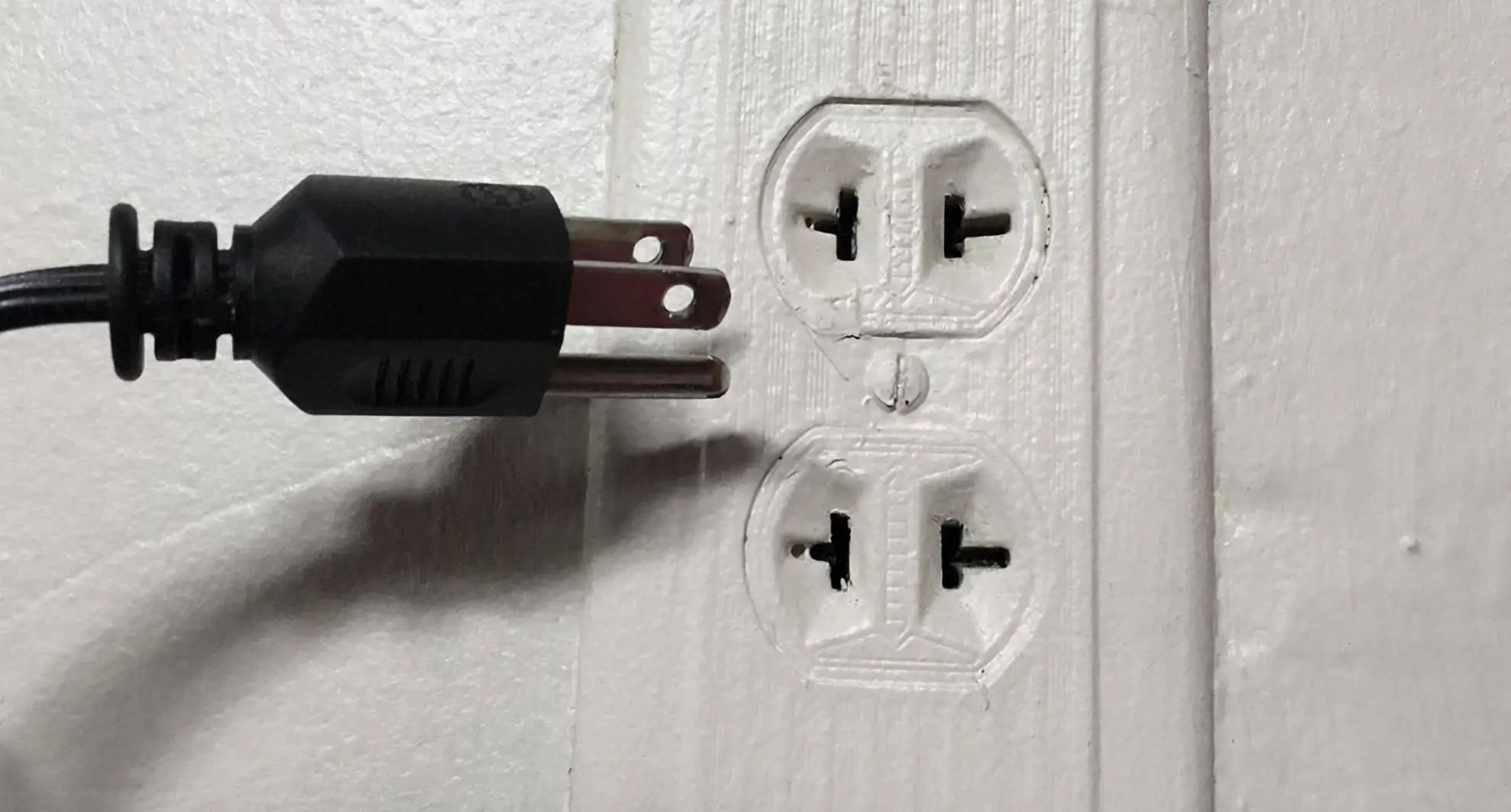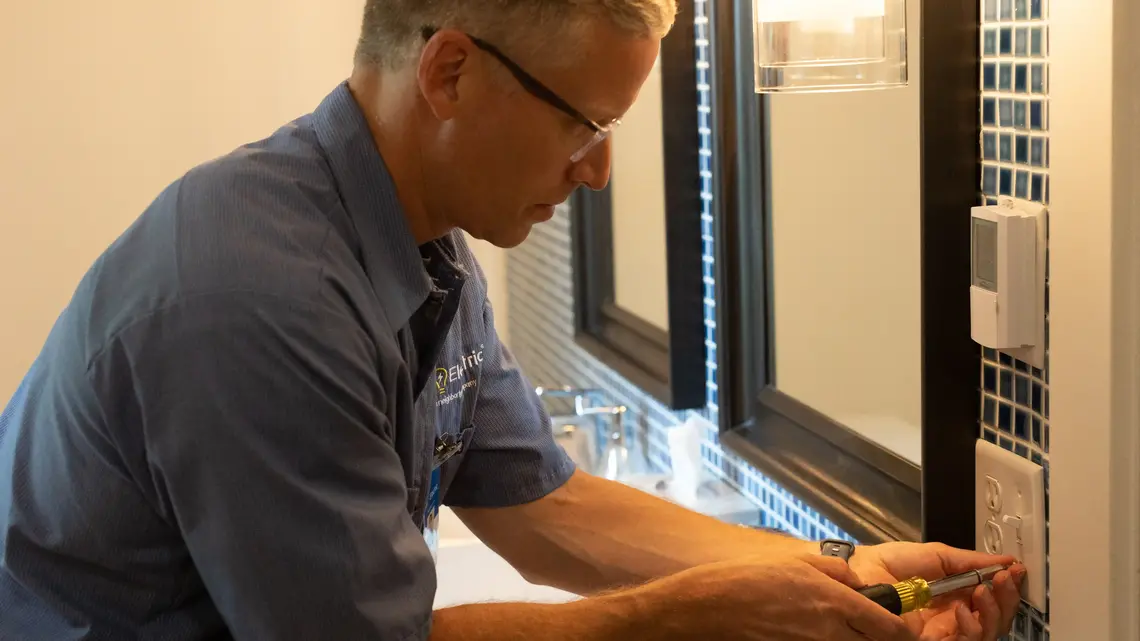
If you live in an older home with two-prong outlets, you’re probably starting to run out of outlet space. Even worse, you probably haven’t been able to make use of your devices that require a three-prong outlet.
Here you’ll learn how changing a two-prong outlet to three-prongs works and what an electrician must consider:
- Can’t I Simple Swap a Two-Prong For a Three-Prong Outlet?
- Should You Change a Two-Prong to a Three-Prong GFCI Outlet?
- How Electricians Replace a Two-Prong with a Three-Prong GFCI Outlet Without a Ground Wire
- How to Ground a Two-Prong Outlet
Can’t I Simply Swap a Two-Prong For a Three-Prong Outlet?
Changing a two-prong outlet to three-prongs isn't necessarily as easy as swapping out one box for another. Why? Two-prong outlets have no ground wire, without which the risk of electrocution and appliance damage is substantial. Simply adding an outlet with an additional prong will give you added appliance access, but it will not give you the safety that grounding provides.
Upgrading your wiring offers the safest solution for three-prong outlet access, it may not be the most feasible one, especially if you’re a renter.
Should You Change a Two-Prong to a Three-Prong GFCI Outlet?
You can. That said, switching a two-prong outlet to an ungrounded three-prong GFCI protects you from electric shock but it will not provide the necessary ground protection that prevents sensitive electronics from being fried during voltage fluctuations.
To meet NEC code and keep your safety and the safety of your electronics in mind, we do not recommend installing ungrounded three-prong outlets.
How Electricians Replace a Two-Prong with a Three-Prong GFCI Outlet Without a Ground Wire
Changing a two-prong outlet to a three-prong is possible without running a new ground wire to the electrical panel. Here’s how professional electricians convert older outlets into three-prong GFCI plugs:
- We turn off the power to the outlet using the service panel and confirm that no electricity is flowing at the outlet with a multimeter.
- We remove the plate screw and cover, as well as the two screws holding the old receptacle into the box.
- We pull out the old outlet box without cracking the wiring. Then we gently extend it to gain access to the wires.
- We disconnect the old outlet.
- Some old boxes are tight. If we can’t fit the GFCI outlet, a new, larger electrical box will be used.
- If the wires aren’t long enough, we add 4-6" extension (“pigtails”) using the appropriate wire for the circuit amperage: 15 amp = 14 gauge; 20 amp = 12 gauge.
Pro Tip for DIYers: If you have significant electrical experience attempting this project, you would have to pick up one white wire and one black wire from a local hardware store, along with the appropriate wire nuts to add the extensions. - If the wires are long enough, the electrician will look at the terminals on the three-prong and identify the “Line” terminals. These are the only ones that will be used. The wires will be connected:
- Black wire to the brass “Line” terminal screw.
- White wire to the silver “Line” terminal screw.
- We gently fold the wires back into the box, pressing in the new outlet.
- We screw the box back into its original location.
- We then test the GFCI outlet by pushing RESET to turn it on, and then TEST to shut it off. We’ll reattach the plate and apply a NO GROUND sticker.
How to Ground a Two-Prong Outlet
To ensure safety, eventually you’ll want to have grounded outlets. If your home is grounded but some of your outlets are not, bringing in a licensed electrician is the best way to ensure the modifications are completed safely and correctly.
Grounding an outlet requires attaching a wire and running it all the way from your outlet to the grounding screw at the back of your electrical box, which is best left to a licensed electrician.
Keeping Outlets Safe in Older Houses
Beyond changing a two-prong outlet to a three-prong, there are other steps you can take to increase safety. Living in an older home doesn’t mean you’re stuck with unsafe wiring—but it does mean you need to stay alert. If you’re holding off on a full upgrade, you can still reduce your risk and keep your electrical system in good shape.
Try not to plug multiple energy-hungry appliances—like space heaters and window A/C units—into the same circuit. Spread them out to avoid overloading. Schedule a licensed electrician to perform a routine checkup every few years, especially if you’ve added new tech or noticed flickering lights.
Make sure cords and outlets stay dry, especially in kitchens, bathrooms, and basements where you don’t have GFCI outlets. And don’t ignore signs of wear—if a cord is cracked, brittle, or frayed, it’s time to repair or replace it before it becomes a hazard.

Changing Your Two-Prong Outlets to Three-Prong? Trust Mr. Electric
If you're interested in changing a two-prong outlet to three-prong, Mr. Electric® is here to help you avoid unnecessary safety risks. Contact us today to upgrade your two-prong outlets safely and efficiently. We back all of our services with the Neighborly Done Right Promise® to ensure your satisfaction.
This article is intended for general guidance only and is not applicable to every situation. You are responsible for determining the proper course of action for your property and situation. Mr. Electric is not responsible for any damages that occur as a result of advice and/or guidance derived from its blog content.
Some Mr. Electric services vary by location. Contact your local Mr. Electric franchise for more information.

